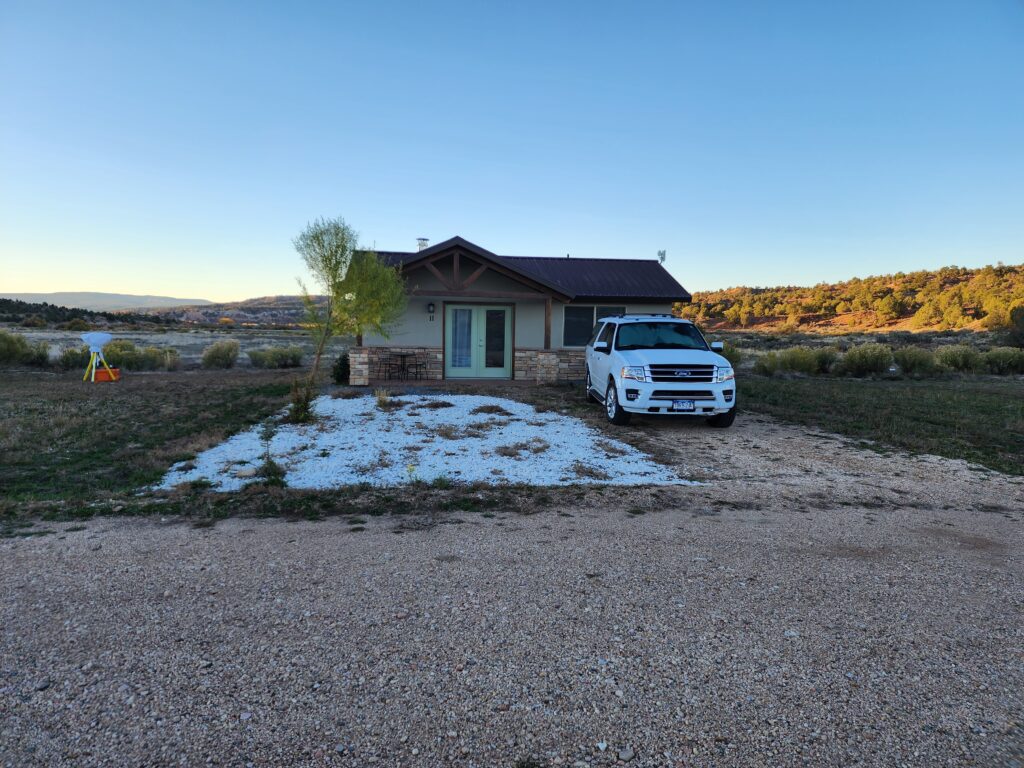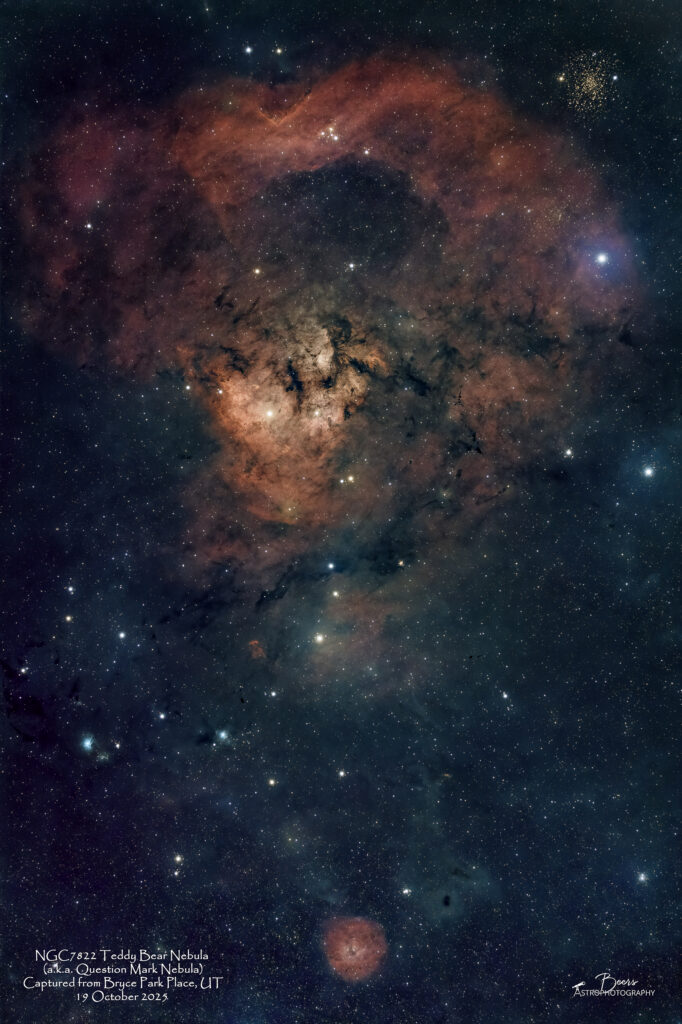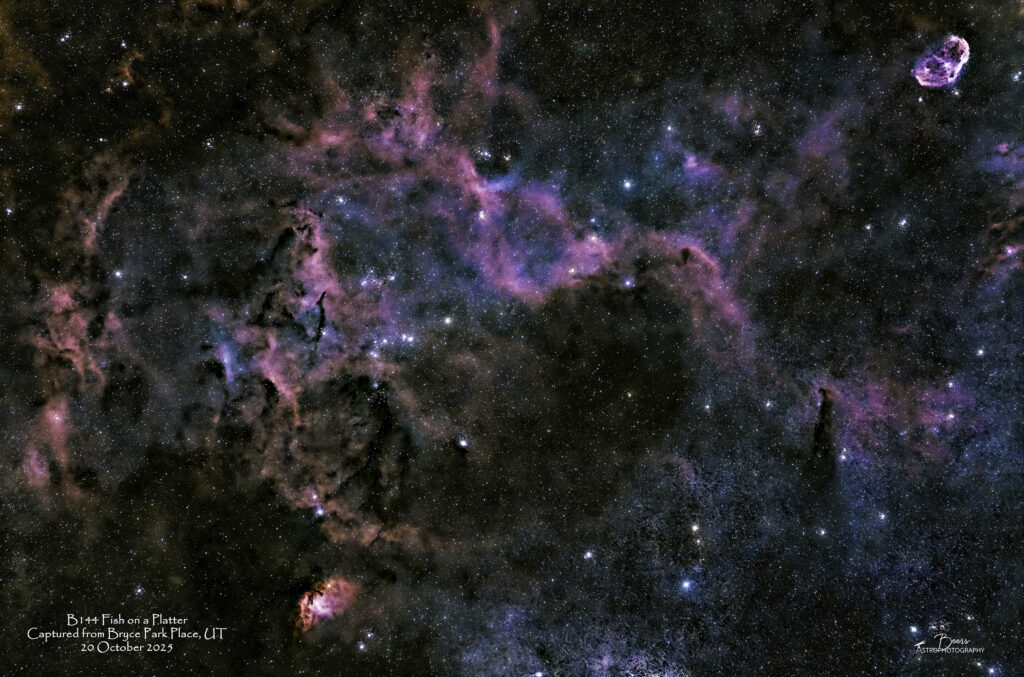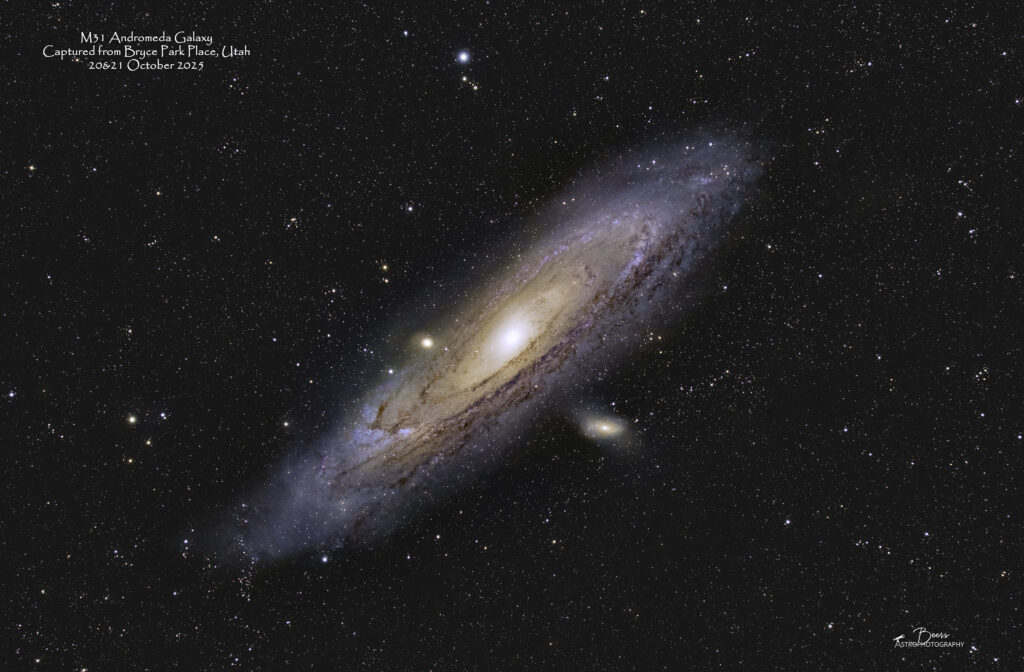My 65th birthday trip was planned to explore possible camping venues on Utah BLM land, look for Milky Way foreground sights, and to capture DSO data from the dark skies of Bryce Park Place in Cannondale, Utah. The trip was a complete success! We decided that driving the Beast this far, to camp on BLM land for DSO imaging purposes didn’t make sense – so we abandoned that objective upon arriving in Cannonville after two long days of driving. We found a few potential Milky Way venues. Mother Nature cooperated with three nights of clear skies, no bugs, and cold (but not unbearably so) overnight temperatures!


My 65th birthday trip was planned with three objectives: 1) explore possible camping venues on Utah BLM land; 2) look for Milky Way foreground sights; and 3) capture DSO data from the dark skies of Bryce Park Place in Cannondale, Utah. The trip was a complete success – all objectives were met! We decided that driving the Beast this far, to camp on BLM land for DSO imaging purposes didn’t make sense – so we abandoned that objective upon arriving in Cannonville after two long days of driving. We found a few potential Milky Way venues, including one along the road near Torrey (when we were still considering a Beast trip) and some within the Kodachrome Basin State Park in Cannondale. For a refreshing change of pace, Mother Nature cooperated with three nights of clear skies, no bugs, and cold (but not unbearably so) overnight temperatures!
Both terrestrial and celestial beauty at every turn…
We drove the Expedition, departing HCH on Saturday morning, 18 October 2025. Spent the night in Green River, Utah – having a fun burger and beer (Polygamy Porter on tap!) dinner at Ray’s Tavern. (Little did we know that would be our last beer or other alcoholic beverage to accompany a meal out until we returned to Grand Junction for a night on the way home – gotta love Utah liquor laws!).
On Sunday morning, 19 October 2025, we took the scenic drive via US-89S, UT-24W, and UT-12W from Green River, through Hanksville, Torrey, Escalante to Cannonville, UT. The drive took us on the outskirts of Capitol Reef National Park, Grand Staircase-Escalante National Monument, and Bryce Canyon National Park. The drive was scenic everywhere we looked whether we were near or National Park or Monument or not! We arrived in Cannonville at about 1400, stopped by the Bryce Park Place (our home-away-from-home for the next three nights) to pick up our key and then headed into town for a late lunch/early dinner. That search took us to Panguitch (about 40 miles away) after the first restaurant we stopped at in Tropic didn’t understand the concept of the ADA or a Service Dog and were going to sit us out on the patio where dogs were allowed (and it was a bit too chilly for that).
Bryce Park Place turned out to be the ideal DSO imaging spot…dark skies and plenty of space to set up adjacent to Unit#11. The imaging weather turned out to be perfect…the clouds cleared while I was going my polar alignment on the first night and didn’t come back until I was packing on my gear on our last morning!
Four DSOs over three nights…
I captured four DSOs: NGC7822 Teddy Bear (Flaming Skull, Question Mark) Nebula, B144 Fish on a Platter Nebula, M31 Andromeda Galaxy, and SH2-119 Clamshell Nebula. On Monday night, I also took a “shot” at Comet C/2025 A6 Lemmon and the Milky Way Core early in the evening; then the Milky Way with the Orionids Meteor Shower early on Tuesday morning. (At the time of this writing (26Oct2025) I have processed the DSOs, but haven’t even looked at any of the Milky Way, comet, or meteor images.)
NGC7822 Teddy Bear (a.k.a. Question Mark; formerly known as Flaming Skull) Nebula
This was the first target on our first night at Bryce Park Place. I had to pause for a few minutes as darkness was descending because there were quite a few clouds in the area. At about 1945, it was clear to the north so I started my polar alignment process. By the time I finished, the skies were clear so I disconnected the PoleMaster and connected all my imaging equipment’s power and control cables. I kicked off the session to a very dark SGP autofocus routine – it took me a few seconds to realize (well into the second or third AF image capture) that I’d forgotten to take off the lens cap on the telescope and autoguide camera! Amazing what the focuser does when it actually has stars to focus on!! …after that false start, I spent the rest of the night collecting data on the Teddy Bear/Question Mark/Flaming Skull.
Speaking of Teddy Bear/Question Mark/Flaming Skull…when I started planning for this trip, all the sources I use to correlate catalogue number with object name seemed to have changed the name from Flaming Skull Nebula to Teddy Bear Nebula or Question Mark Nebula. After staring at the previously captured images, I’d finally “seen” the skull (especially in the image I captured from the Comanche National Grasslands in October 2024). I’m definitely seeing the Question Mark, especially with the Southern Cross’ 0.7x Reducer expanded field of view (420mm), but I’m having a harder time seeing the Teddy Bear in the image. A little off-topic science for you…perhaps the reason I’m not seeing a teddy bear: the term for remembering the first thing you see in an image is the primacy effect. It is a cognitive bias in which the first piece of information encountered is recalled more easily and given more weight than subsequent information.
The full “story” of this DSO, capture details and previously captured images (clearly showing the Flaming Skull(!)) are in the gallery at: https://beersastrophotography.com/gallery/ngc7822-flaming-skull-nebula/

B144 Fish on a Platter Nebula
This was a new target that I discovered on Telescopius while I was doing my planning for our September dark skies trip. I was excited to have an opportunity to image a new dark nebula under dark skies, but the mosquitoes chased us out of New Mexico’s Kiowa National Grasslands in September before I had the chance. So I transitioned it to my October target list and captured it as my first target at the beginning of our second night at Bryce Park Place.
Since there’s quite a dearth of information about this object and very few examples of astrophotographers who actually see a “fish on a platter” in their images, I’ll make a few editorial comments.
First, a statement of the obvious…there’s a lot going on here! This is a dark nebula buried in a very dense star field (Cygnus Star Cloud). If I cheat and look at the star field in the raw image stack I can almost see a nose of a fish near the center of the image pointing to the northeast, with its body laying (on a platter of stars?) in an arch down to the southwest and its tail swooping up to the northwest. A good friend of mine, after viewing the image stated seeing the fish in the blue nebulosity near the center. With that suggestion in mind, I too, can see that blue nebulosity fish but can’t unsee my dark nebulosity fish (see the primacy effect description above). Perhaps this object should be renamed “Two Fish on a Platter” for the blue nebulosity fish laying on top of the dark nebulosity fish?? Okay, maybe I’m getting a little carried away… All that photographic interpretation aside, it may take a lot of staring and perhaps a drink or two, to begin to really see a fish or two!
One comment closer to “fact”…it is interesting to note the SH2-101 Tulip Nebula in the bottom of the SW quadrant and the NGC6888 Crescent Nebula in the top NE corner of the image. I have imaged both of those DSOs with my bigger telescopes (Big Zeus and Big Bertha, respectively) and filled the frame with them! Using the Southern Cross and the 0.7x focal length reducer they look like little blob afterthoughts. Illustrating the old adage “space is big”!
The “full story” (what little is known of it) and capture details are in the gallery here: https://beersastrophotography.com/gallery/b144-fish-on-a-platter-nebula/

SH2-119 Clamshell Nebula
The full (sorted) story of this DSO collection is in the gallery at: https://beersastrophotography.com/gallery/sh2-119-clamshell-nebula/
Here I’ll just pique your interest with the highlights…
- During the day on Tuesday (our last day of the Utah 65th Birthday trip), I got the bright (okay maybe not so bright) idea to image the SH2-129 Flying Bat/Giant Squid with my new ZWO ASI6200MM mono camera and the OIII filter that I’d brought with me.
- At about 14:30MDT, I started to disassemble the OSC camera and 0.7x reducer to replace the camera with the mono camera and install the OIII filter into the reducer’s image train.
- Once the equipment was assembled, I tried to calculate the correct exposure settings for the flat frames (and capture all the calibration frames to save time in the morning when we were going to be packing up to leave) – outside in the bright sunlight at about 16:00MDT
- In the sunlight, I couldn’t see the laptop screen and I couldn’t tell if the light pad was on or off!
- I finally gave up after about 30 minutes of struggling when I started getting error messages on the camera connection and found that it was only downloading about half of the images in the calibration frame sequence.
- …apply your OT&E experience before taking the new equipment into “combat” Suzanne!!
- So, I disassembled the mono camera and the 0.7x reducer (taking the OIII filter back out of its imaging train) and reassembled the Southern Cross with the OSC camera and 0.7x reducer
- With the original equipment back in place, I made a plan to image SH2-119 Clamshell Nebula..after a quick search of my website and journals led me to (erroneously) believe I’d never imaged SH2-119 under dark skies
- I really do need to build that database – so all my data collection, journaling, planning, captured images, training, etc. information is all in one place!
- I had some sequence start-up issues and an unexpected termination over an hour before it was to set, but I did collect 5:30 hours of data in dark skies

M31 Andromeda Galaxy
Again, motivated by our neighbor Sandy’s enthusiasm for this image and realizing that all the reprocessing of my front-patio imaging data will never get an image as colorful and vibrant as one captured in dark skies, I prioritized reimaging M31 to gather dark skies data high on my target list. Since M31 was setting at 06:30MDT, about the start of astronomical twilight when I end my imaging sessions in the morning, I imaged it on both Monday and Tuesday nights after the earlier setting B144 and SH2-119 set.
The full “story” of this DSO, capture details and previously captured images (clearly showing the Flaming Skull(!)) are in the gallery at: https://beersastrophotography.com/gallery/m31-andromeda-galaxy/

